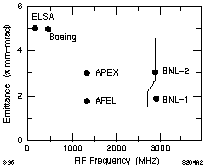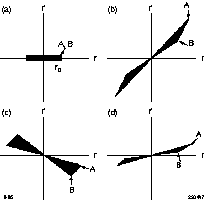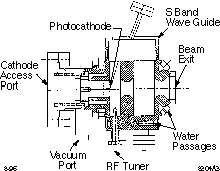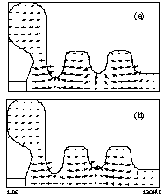RF photoinjectors have been under intensive development
for the past decade since they promise to be the high-brightness
electron beam sources required for FELs. Progress has been sufficiently
good to make optically switched RF photoinjectors attractive candidates
as injectors for future colliders, especially those colliders
which plan to use complex beam pulse structures. Although present
RF photoinjectors will not today meet all the requirements of
some collider designs, their potential capabilities seem greater
as well as more versatile than conventional injectors. The present
status and future goals of RF photoinjectors are compared. The
principal problems remaining for achieving these goals while also
providing high reliability for linacs during continuous, long-term
operation are examined.
The first use of rf photoinjectors was in 1985 at LANL by Fraser, Sheffield, and Gray.[1] The initial tests rapidly evolved into a working model of an rf gun at LANL for application with free electron lasers (FEL),[2] and rf photoinjectors are now routinely employed as electron sources for a large variety of FEL designs.
Very early it was realized that photoinjectors were
potentially the best solution for an electron source for linacs
that require a complex pulse train, since the optical system that
drives the cathode is usually more suited to the time frame of
the pulse structure than a fast pulser driving a grided, thermionic
cathode. Numerous test linacs with rf photoinjectors are now in
operation or planned that are proving this concept viable.

Finally, since a future electron-positron collider will require that the electron beam be polarized, there is hope and increasing evidence that this might be doable using an rf photoinjector.
The basic components of an rf photoinjector, illustrated in Fig. 1, consist of an rf gun with a photocathode, a laser and optical system producing the desired pulse structure, an rf source, and a timing and synchronization system.
RF photoinjectors were last reviewed at a Linnac Conference by Stovall[3] at the 1992 meeting in Ottawa. More recent reviews are by Sheffield,[4] O'Shea,[5] and Travier.[6] Reference 6 along with an earlier review,[7] also by Travier, provides an excellent summary of present rf photoinjector projects.
In the sections that follow, recent progress of photoinjectors
for FEL and collider applications will be examined.
Until recently the LANL rf guns, which operate at L-band frequency, used CsK2Sb photocathodes, which provide lifetimes under operating conditions of some tens of hours. An S-band gun was developed at BNL that uses a metal cathode such as Cu or Mg. In the vacuum environment of the gun, a metal cathode is very robust, however the high work function and low QE associated with metal cathodes necessitates a very high-power UV laser.
Cs2Te cathodes have been developed at CERN for use with an S-band gun.[8] These cathodes maintain a QE >1% at 262 nm for many weeks in the operating gun,[9] but cannot be exposed to air. CsI cathodes can be exposed to air, but their QE is considerably lower.
The experimental effort necessary to establish the viability of an activated III-V semiconductor in a high-power rf gun for producing polarized electrons has only just begun.[10,11]
Unfortunately, the perfect photocathode, whether
or not suitable for polarized electrons--one with high QE in the
visible, near infinite livetime, and able to recover readily after
exposure to air--has so far eluded investigators.
The universal gain parameter, r,
for an FEL is a simple function of the beam brightness,[12]
![]() .
.
The appeal of rf photoinjectors for FELs is that a high brightness beam can be produced directly from the gun. This is a major advantage, especially when the electron accelerator itself is small and the whole FEL system may be less costly than alternative high-brightness injector systems, such as a pulsed, grided, thermionic gun followed by an rf longitudinal bunching system and a damping ring for reducing the transverse emittance.
The peak normalized rms brightness is given by
![]()
in units of A(m-radians)-2, where ![]() is the peak current, sz
is the rms bunch length, and
is the peak current, sz
is the rms bunch length, and ![]() , the normalized
transverse rms emittance in the s-s' plane, is
, the normalized
transverse rms emittance in the s-s' plane, is
![]() ,
,
where s is either x or y. The mks units for en,s are p m-radians, where the p attached to the units is used to distinguish the numerical results from those associated with the area of an ellipse which (in limited cases) bounds the phase-space domain representing the particles in the bunch.[13]
High current densities at the cathode are desirable
in order to minimize the transverse emittance. Thermionic cathodes
are limited to something on the order of 10 A/cm2, whereas photocathodes
can easily produce peak current densities that are much higher:
more than 3000 A/cm2 have been extracted from Cs2Te cathodes in
the CLIC Test Facility (CTF) S-band rf gun at CERN illuminated
by 262-nm light from a quadrupled Nd:YLF laser system.[14]
The space-charge limit is significantly higher. For a bunch length
that is less than the transit time of the bunch through an rf
cavity, the space-charge limit may be approximated using Gauss'
Law, ![]() . For acceleration 30 degrees off the
crest of an rf field of 100 MeV/m, s
= 44 nC/cm2, which translates to 5500 A/cm2 for the 8 ps FWHM
pulse as used for the CTF measurement above.
. For acceleration 30 degrees off the
crest of an rf field of 100 MeV/m, s
= 44 nC/cm2, which translates to 5500 A/cm2 for the 8 ps FWHM
pulse as used for the CTF measurement above.
The high electric fields produced by rf guns are
necessary both to extract the high currents and to minimize the
effects of space charge on emittance growth while the bunch is
accelerated to relativistic energies where the space-charge forces
vanish. The lower limit of emittance in a gun can be approximated
by the thermal normalized emittance,[15]
![]() .
.
For a laser driven photocathode, rc is the rms radius of the laser spot on the cathode and Te is the effective temperature of the photoelectrons.[16,17] Assuming rc = 0.5 mm and an effective temperature of 0.2 eV, the normalized thermal emittance for a high-gradient rf gun is about 0.3 p mm-mrad. This low an emittance is not realized in practice because of the dominance of several mechanisms which compete to increase the emittance. The principal mechanisms are space charge and rf fields.
Analytical expressions for space-charge and rf-induced
emittance growth have been derived by Kim.[18]
If the aspect ratio ![]() of the bunch is <1,
then the transverse emittance growth due to space charge is given
by
of the bunch is <1,
then the transverse emittance growth due to space charge is given
by
![]() ; i=x or y.
; i=x or y.
Here Eo is the maximum rf field at the cathode, fo
is the rf phase at extraction, and mi(A)
~O(1) for AÆ0.
The rf-induced emittance growth for a bunch of negligible charge
is given by
![]() ,
,
where k=2p/l is the wave number of the rf field. Clearly the rf emittance increases with increasing initial acceleration while the space-charge emittance decreases.

These equations along with the practical limitations of rf cavities, photocathodes, and associated laser systems provide the basic tools needed for designing a high brightness rf photoinjector system. However, the detailed design for the rf gun is usually the product of a computer simulation using standard codes such as MASK and PARMELA. Figure 2, which follows reference 5, shows the measured emittance for a number of optimized rf photoinjectors spanning a large range of operating frequencies, n. BNL-1 (2) is an early (later) version of the photoinjector for the Accelerator Test Facility (ATF) at BNL. The emittances shown for BNL-1 and 2 have been scaled to 1 nC using the charge scaling of Rosenzweig and Colby.[12] Fig. 2 shows that the beam emittance of gun designs optimized for a fixed, relatively modest charge is flat or perhaps weakly decreases as frequency increases, consistent with the scaling of reference 12. Using the same data as for Fig. 2, Bn is calculated to be 0.4, 0.2, 2.3, 6.2, 4.0, and 2.5x1013 A(mm-mrad)-2 for ELSA, Boeing, APEX, AFEL, BNL-1 and 2 respectively--values that generally increase with n, again consistent with reference 12.
The measured emittances shown in Fig. 2 are as much
as a factor of 10 lower than those predicted by Kim's equations.

The principal reason is that these injectors (excepting BNL-1) utilize a scheme introduced in 1989 by Carlsten[26] which compensates for a significant portion of the emittance growth due to space charge. To understand how this scheme works, let us assume an initially uniform distribution of charge as shown in Fig. 3, where r and z are internal coordinates for the radial and axial coordinates respectively of the distribution.

The axial center at the initial radius r = ro is tagged A while the equivalent point at the axial edge is tagged B. Points A and B represent transverse slices in the axial charge distribution. The space charge forces in the middle of the bunch are greater than at the ends, so that after allowing some drift, point A has expanded in phase space more than point B as illustrated in going from (a) to (b) in Fig. 4, resulting in a characteristic fan shape. If at this point, the beam passes through a linear lens, the phase space is rotated from the first to the fourth quadrant as shown in going from (b) to (c). As can be seen, point B is now compressed more than point A, reversing the effects of space charge. As the bunch continues to drift under the influence of the space-charge forces, the fan tends to first close until near the waist the points A and B cross in going from negative to positive r', after which the fan again spreads. At or near the waist, the slices are once again lined up and the emittance goes through a minimum. If this minimum emittance occurs as the bunch is accelerated inside a linac, the reduced emittance can be frozen since the space-charge forces decrease as g-2. As a practical matter, a compensating solenoid is located near the rf gun followed by a drift and a linac. Although this emittance compensation technique has been employed by a number of photoinjectors for several years, the first measurement of the relative rotation of the slice phase space distributions for various settings of the compensating solenoid were only recently reported by Qui and colleagues using the 1-1/2 cell S-band photocathode rf gun of the ATF.[27]
The success of the one and 1-1/2 cell gun developed at BNL for the ATF is evident by the frequency with which it has been copied--some dozen examples are now in use. S-band cavities can be operated at a higher accelerating gradient than L-band, thus minimizing the axial distance over which the space-charge forces are strong. A cross section of an early version of the gun is shown in Fig. 5.[28] The cavities are designed to operate in p-mode in the standard TM01 pattern.

The thickness of the disks and the radius of the aperture is adjusted to linearize the radial dependence of the transverse electric and magnetic fields. RF power is coupled directly to both cells. The coupling aperture is adjusted to avoid coupling to the zero mode. The early gun featured a removable cathode plug that allowed flexibility for cathode studies, but breakdown and field emission at the associated rf choke joint necessitated operation at lower than optimum fields. The experimental results from this gun are labeled BNL-1 in this paper. Since a Cu cathode can satisfy the demands of the ATF, a new version of the gun designed to reduce the beam divergence was built with a full Cu wall, thus eliminating the rf choke.[29] The results from this gun are here labeled BNL-2.
Proposals for increasingly shorter wavelength linac-based
FELs such as the VUV FEL at the TESLA Test Facility at DESY[30]
and the Linac Coherent Light Source (LCLS) at SLAC[31]
indicate the need for electron sources with higher brightness
than presently exist. Consequently there is new motivation to
understand and reduce the remaining effects of emittance grown.
To this end a new 1.6 cell S-band gun that is designed to minimize
emittance growth due to multi-pole modes[32]
is now being commissioned at the ATF.[33]
The first cell has been lengthened to increase the rf focusing.
The rf side-coupling for the first cell, which was designed to
suppress the zero-mode, has been eliminated in favor of a larger
cell iris which increases the mode separation.
Present designs for future high-energy colliders mostly require complex pulse trains in which the individual pulses are either very closely spaced or have high charge or both.[34] Although all but one of the present collider designs require a transverse emittance that can only be achieved with damping rings, it has been recognized that a lower emittance from the electron source will ease the damping ring requirements.[35] For TESLA, the desired emittance is high enough to allow for at least the possibility of using a low-emittance rf photoinjector without an electron damping ring. For the important two-beam design of the Compact LInear Collider (CLIC),[36] the very complex pulse train required for the drive linac would be very difficult to produce other than with an rf photoinjector.
RF photoinjectors can produce the extremely high charge required in some linac applications. The L-band gun for the Argonne Wakefield Accelerator (AWA) drive linac was designed to produce 100 nC bunches from a 2-cm diameter Mg cathode. Using a picosecond UV laser, as much as 40 nC/pulse have been extracted in the linear regime. The bunch length was measured to be 27 ps FWHM at 30 nC/pulse and the corresponding emittance 17 p mm-mrad. Increasing the laser energy into the non-linear regime but staying below the explosive limit, a maximum of 56 nC/pulse has been observed.[37]
The CTF was constructed at CERN to study the generation of 30 GHz rf (required for the CLIC drive beam) using an S-band rf photoinjector and linac. The rf gun used in 1994-95 was similar to the BNL design shown in Fig. 5. To generate the desired 30 GHz rf power, the CLIC drive beam is required to produce 1 mC of charge in a total of 48 successive S-band buckets. At the gun, a charge of up to 35 (450) nC was successfully produced in a single bunch (48 bunch train).[9] Although this charge is nearly sufficient at the gun, the transmission through the 30 GHz rf structures remains a problem. The poor transmission is being addressed by a number of recent changes to the CTF including a new 2-1/2 cell gun[17] with a larger iris aperture. The radial focusing is enhanced by a conical backplane around the cathode and by slightly elongating the first cell. The second and third cells are slightly shortened to reduce the energy dispersion caused by space-charge forces.
The multiple-bunch high charge in the CTF beam results
in two serious problems. First, because of beam loading, the emittance-compensating
solenoid progressively over-focuses the bunches as a function
of distance behind the lead bunch, significantly increasing the
emittance. Second, beam loading causes significant phase slippage
as a function of axial position in the first cell where the bunches
are still non-relativistic. This latter problem cannot be corrected
by normal beam-loading compensation techniques after the gun.
A novel gun design has been proposed that is expected to greatly
reduce these effects.[38]
The new gun will more than triple the stored energy in the first
cell. This is accomplished by designing the first cell to operate
in the TM02 pattern, while the following two cells operate in
the TM01 pattern. In the no load condition, the p-mode
will dominate as shown in Fig. 6(a). However, in the presence
of the bunch train, the gradient in the first cell to drops due
to the admixture of the zero-mode shown in Fig. 6(b). These two
modes add in the first cell and subtract in the second as desired
to reduce phase slippage. In addition, by adjusting the overall
gradients in the gun to balance the focusing effect of the solenoid,
one should be able to reduce the emittance of the bunch train
to the order of the single bunch emittance. A gun of this design
is now under construction at CERN.

Future e+/e- colliders will require that one or both of the beams delivered to the interaction point be polarized. The DC-biased photoinjector at SLAC has been successfully delivering polarized electrons for all operations of the SLAC 3-km linac including the SLC since 1992.[39] The principal element is a GaAs photocathode photoexcited at the band gap energy. The prospects for generating polarized electrons using an rf gun were first discussed in 1993.[40] The principal problems are the effect of a semiconductor cathode on the rf cell, the viability of an activated GaAs cathode in the vacuum of an operating rf gun, the time response of a high-QE semiconductor, and the field emission that may result when a cathode with a negative electron affinity (NEA) surface is exposed to high rf fields. The first of these problems was recently addressed in a test using the CTF gun. First a 356-mm thick GaAs crystal was glued at SLAC to a modified cathode plug using indium. After transfer to CERN, the crystal (the surface was not activated) was tested in the CTF gun with rf fields as high as 85 MV/m. The rf operation of the cavity, including the field emission, appeared normal.[9,10]
There is an international effort now underway to study the remaining problems.[41] A 2-1/2 cell gun of the CERN design with the TM02 pattern in the first cell is being constructed at Nagoya/KEK to be used at the CTF.[42] Special fabrication techniques will be employed that should significantly reduce dark current.[43] Since dark current is probably the major source of vacuum degradation that will affect an NEA crystal, this gun may prove to be an important test platform for the generation polarized electrons. Finally, there is rapid progress in determining the photoemission response time of GaAs. Recent measurements[44] are consistent with a response time of "10 ps for a high-polarization (80%) III-V crystal with a 100-nm epilayer.
Rapid progress is being made to develop higher brightness
rf photoinjectors in response to the requirements of proposed
short-wavelength FELs. Likewise, rf photoinjectors have been successfully
optimized for high charge and/or complex pulse profiles for use
with colliders and other linac applications. The possibility of
producing polarized electrons with an rf photoinjector is being
investigated.
[1] J.S. Fraser, R.L. Sheffield, and E.R. Gray, in Laser Acceleration of Particles, eds. C. Joshi and T. Katsouleas, AIP Conf. Proc. 130 (1985), p. 598; and J.S. Fraser, R.L. Sheffield, and E.R. Gray, Nucl. Instrum. and Meth. A 250 (1986) 71.
[2] P.G. O'Shea et al., Nucl. Instrum. and Meth. A 318 (1992) 52; and K.C.D. Chan et al., Nucl. Instrum. and Meth. A 318 (1992) 148.
[3] J. Stovall, Proc. of the1992 Linear Accelerator Conference, 24-28 August, 1992, Ottawa, Ontario, p. 285.
[4]R.L. Sheffield, Proc. of the 1995 Particle Accelerator Conference, 1-5 May, 1995, Dallas, TX, p. 882.
[5] P.G. O'Shea, Nucl. Instrum. and Meth. A 358 (1995) 36.
[6] C. Travier, in Advanced Accelerator Concepts, ed. P. Schoessow, AIP Conf. Proc. 335 (1995), p. 57.
[7] Particle Accelerators 36 (1991) 33.
[8] E. Chevallay et al., Nucl. Instrum. and Meth. A 340 (1994) 146.
[9] H.H. Braun et al., "Results from the CLIC Test Facility," contributed to the European Particle Accelerator Conference, 10-14 June, 1996, Stiges, Spain.
[10] K. Aulenbacher et al., "RF Guns and the Production of Polarized Electrons," CLIC Note 303 and NLC Note 20 (1996).
[11] Testing of GaAs photocathodes in an rf gun is underway at BINP. A. Novokhatski (BINP), private communication.
[12] J. Rosenzweig and E. Colby, in Advanced Accelerator Concepts, ed. P. Schoessow, AIP Conf. Proc. 335 (1995), p. 724.
[13] C. Lejeune and J. Aubert, in Applied Charged Particle Optics, Part A, ed. A. Septier, (Academic Press, San Diego, 1980), p. 159.
[14] R. Bossart et al., Proc. of the 1995 Particle Accelerator Conference, 1-5 May, 1995, Dallas, TX, p. 719.
[15] J. D. Lawson, The Physics of Charged-Particle Beams, 2nd ed. (Clarendon Press, Oxford, 1988), p. 210.
[16] The effective temperature of the photoelectrons can be derived from Schottky effect measurements. For high QE cathodes, a value near 0.2 eV is found. For GaAs, see H. Tang, Proc. of the 1993 Particle Accelerator Conference, 17-20 May, 1993, Washington, DC, p. 3036; for Cs2Te, see reference 17.
[17] R. Bossart et al., "A 3 GHz Photoelectron Gun for High Beam Intensity," CLIC Note 297 and PS/RF Note 95-25 (1995).
[18] K.J. Kim, Nucl. Instrum. and Meth. A 275 (1989) 201.
[19] A. Loulergue et al., Proc. of the European Accelerator Conference, 27 June - 1 July, 1994, p. 725.
[20] D.H. Dowell et al., Appl. Phys. Lett. 63 (1993) 11.
[21] P.G. O'Shea et al., Nucl. Instrum. and Meth. A 331 (1993) 62.
[22] R.L. Sheffield et al., Nucl. Instrum. and Meth. A 341 (1994) 371.
[23] K. Batchelor et al., Nucl. Instrum. and Meth. A 318 (1992) 372.
[24] X.J. Wang et al., Proc. of the 1995 Particle Accelerator Conference, 1-5 May, 1995, Dallas, TX, p. 890.
[25] B.E. Carlsten, Nucl. Instrum. and Meth. A 285 (1989) 313.
[26] B.E. Carlsten, Particle Accelerators 49 (1995) 27, and references therein.
[27] X. Qiu et al., Phys. Rev. Lett. 76 (1996) 3723.
[28] K. Batchelor et al., European Particle Accelerator Conference, 12-16 June, 1990, Nice, FR, p. 541.
[29] X.J. Wang et al., Proc. of the 1993 Particle Accelerator Conference, 17-20 May, 1993, Washington, DC, p. 3000.
[30] "A VUV Free Electron Laser at the TESLA Test Facility at DESY," Conceptual Design Report, TESLA-FEL 95-03 (6/95).
[31] R. Tatchyn et al., Nucl. Instrum. and Meth. A 375 (1996) 274.
[32] D.T. Palmer et al., Proc. of the 1995 Particle Accelerator Conference, 1-5 May, 1995, Dallas, TX, p. 982 and p. 2432.
[33] D.T. Palmer (SLAC), private communication.
[34] R.H. Siemann, Proc. of the 1993 Particle Accelerator Conference, 17-20 May, 1993, Washington, DC, p. 532.
[35] Summary of Working Group 2, Proc. of the International Workshop on e+e- Sources and Pre-Accelerators for Linear Colliders, ed. R. Wanzenberg (DESY, 1994), p. 239.
[36] H. Braun et al., Proc. of the 1995 Particle Accelerator Conference, 1-5 May, 1995, Dallas, TX, p. 716.
[37] P. Schoessow, Proc. of the 1995 Particle Accelerator Conference, 1-5 May, 1995, Dallas, TX, p. 716.
[38] R. Bossart and M. Dehler, "Design of an RF Gun for Heavy Beam Loading," contributed to the European Particle Accelerator Conference, 10-14 June, 1996, Stiges, Spain.
[39] R. Alley et al., Nucl. Instrum and Meth. A 365 (1995) 1.
[40] J. Clendenin et al., Nucl. Instrum. and Meth. A 340 (1994) 133.
[41] The collaboration was initially formed in early 1996, by CERN, KEK/Nagoya, and SLAC.
[42] T. Nakanishi (Nagoya) and H. Matsumoto (KEK), private communication.
[43] M. Yoshioka et al., Proc. of the 1994 International Linac Conference, August 21-26, 1994, Tsukuba, JPN, p. 302.
[44] P. Hartmann et al., "Picosecond Polarized
Electron Bunches from a Strained Layer GaAsP Photocathode,"
to be published in Nucl. Instrum. and Meth.; also A.V. Aleksandrov
et al., Phys. Rev. E 51 (1995) 1449.